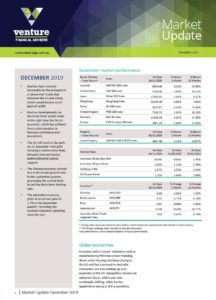The Pulse

- Markets have reacted favourably to the prospect of a ‘phase one’ trade deal between the US and China, which would involve a roll-back of tariffs.
- Positive developments on the trade front would come at the right time for the US economy, which has suffered from a deterioration in business confidence and investment.
- The UK will head to the polls on 12 December with polls showing a Conservative lead, but polls have previously underestimated Labour support.
- The Chinese economy slowed to a 6.0% annual growth rate in the September quarter, prompting the central bank to cut the short-term lending rate.
- The Australian economy grew at an annual pace of 1.7% in the September quarter, recording the weakest consumer spending since the GFC.
Australia
The Reserve Bank kept the cash rate at a record low 0.75% as widely expected and offered guidance that a rate cut was unlikely owing to some slight improvements in the domestic economy as well as the global trade picture. It seems the RBA is pleased with the response of the housing sector to the rate cuts although there is little evidence elsewhere of a response to date. Global risks may have eased with the trade truce but have not completely disappeared.
Global economies
Economic data is mixed. Indicators such as manufacturing PMIs have been trending down, while housing has been strong in the US and has improved in Australia. Consumers are also holding up well, especially in the US. Geopolitics remains an unknown factor, with trade talks continually shifting, while further quantitative easing is still a possibility.
US
Federal Reserve Chairman Jerome Powell reiterated his view that interest rates are probably on hold after three straight reductions, while signalling that the Fed could resume cutting if the growth outlook falters. Markets are now factoring in only one further cut in the Fed funds rate, implying a rate of 1.4% by mid-2020 and 1.3% by end-2020.
Europe
Recent PMI data suggest that GDP was rising at a 0.1% rate at the start of the December quarter, but likely with a weakening trend. Growth remains soft in Europe while Germany narrowly avoided a technical recession in the September quarter, growing 0.1% after contracting 0.2% in the March quarter.
China
There is no clear evidence that the Chinese economy has stabilised. While credit growth appears to have lifted, indictors of consumer spending, investment and production appear to be slowing. In the September quarter the Chinese economy slowed to just 6%, the slowest annual pace in almost 30 years and growth for the current quarter could be lower.
Asia Region
Japan’s economy grew faster in the September quarter than originally estimated, recording annualised GDP growth of 1.8%, revised upwards from 0.2%. Despite falling exports, local demand has kept the economy in expansion mode, however there are concerns that the rise in the consumption tax rate in October may have resulted in buying decisions being brought forward.